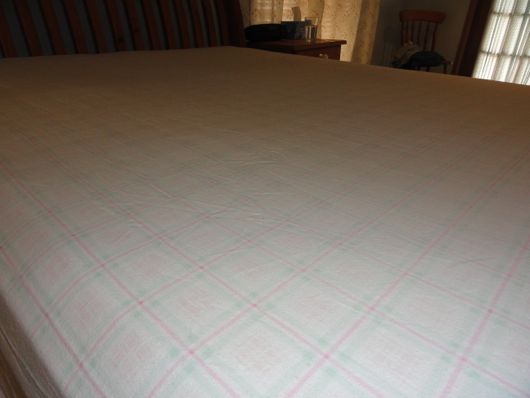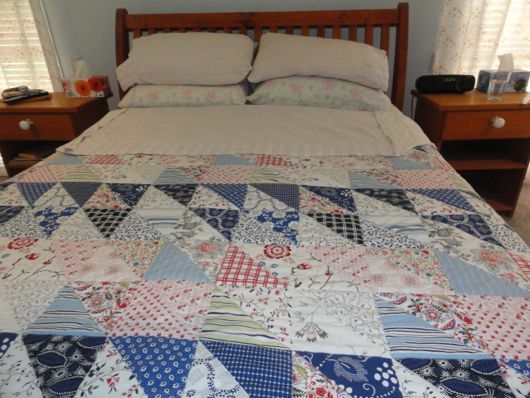Wow. The Blackheath workshop is almost full. Thanks to everyone who booked yesterday. I'll get details out to you in the next couple of days. There has only been one inquiry about the other workshop further west. We decided to do it in Bathurst after all but if there is no further interest, we'll probably do both workshops in Blackheath. Please let me know so I can book the venues.
Also, I'm going to link to everyone who is taking part in yesterday's list challenge. If you want to be part of that, please email your link to your list post so I can include it - rhondahetzel@gmail.com
- - - - ♥ - - - -
A couple of months ago, Kim asked me to write a post about making a bed with hospital corners. Well, it may have taken a bit too long to get to it but today we have it - making your bed. This is one of my favourite topics. I love it because it's one of those most ordinary of tasks that many people don't think about, but when you do, you realise what a profound act it is. Many of us may be guilty at times of not looking after ourselves properly. This one small act of making the bed, is high up on the list of household tasks that help care for you, the homemaker and maker of the bed. It will make you feel better. If not when you do it, then certainly when you go to bed.
We all know how important it is to make a baby's bed. Those small bundles spend a lot of time in their beds in those first few months and generally parents know that the bed has to be clean, dry and warm enough. That little bed will hold your baby when you can't, it has to be safe secure and comfortable.
Your bed is the same. It may not be made up with fresh sheets quite as often as a baby's bed but it's just as important that your bed will hold you safely and securely and that when you go to bed after a hard day's work, the comfort you find there relaxes you and helps you sleep. Sleep is a strange thing. We still don't really know why we sleep but all of us do. Usually once every 24 hours we loose consciousness and lay silent for hours. We don't know what's going on around us, we don't know what time it is, we don't respond. Knowing all this, I guess it makes sense to have a bed that keeps us warm and comfortable, and will safely hold us during those hours we lay silent.
I don't make my bed with hospital corners anymore. I learnt the technique when I was a nurse in the 60s and 70s and it's just one of those simple things that always stays with you. I use fitted bottom sheets now and I don't tuck in the top sheet at the bottom on the bed now because both Hanno and I like to poke our feet out from under the sheets and quilt.
Always start off with a bottom sheet that is completely flat, with no creases. If you don't use fitted sheets like I do, lay a flat sheet out on your bed, make sure there is an even hang on both sides and then tuck in the top of the sheet under the mattress. Pull it tight because creases in the sheet you lay on will be uncomfortable. If you're making the bed for someone who is elderly or frail and they spend a lot of time in bed, creases have the potential to start bed sores. So just take the time to run your hand over the bed to make sure no creases remain before you tuck in the top or bottom of the sheet. See below for how to make the hospital corners. You would do that top and bottom is you're using a flat bottom sheet and just at the bottom for the top sheet.
Lay the top sheet on top of the bottom sheet and smooth it out with an even hang on both sides of the bed. The goal here is to provide warmth on both sides of the bed with a good enough hang as well as comfort for the toes and feet.
If you make the top sheet too tight, it will cause pressure on your toes. When I was taught how to make a hospital bed, we always added a pleat at the bottom of the bed so the sheet could easily expand to accommodate the feet. So right in the middle of the sheet, pull the sheet in from both sides and make a pleat. Don't worry about the pleat looking untidy. It will be completely cover and flattened by your top layers.

When you get into bed with the pleat at the bottom, the pleat will expand out to give your feet the room they need.
Then, to make the hospital corners, standing at the side of the bed near the end, lift up the side of the sheet so it looks like the above and lay the mitred corner on the bed. Then tuck in the bit that's hanging down.
You will then have a corner that looks neat, like this.
Then take the sheet corner that is still laying on the top of the bed and tuck it securely under the bed, giving you a firm mitred corner - a hospital corner.
In hospital, they used to tuck in the sheets along the side of the bed. I'm not sure if they still do that but it makes a really tight bed. I prefer to have a bed with the top sheet fairly loose, so I never tuck in the top sheet.
Some other things to remember when making your bed is to not have the top layers too heavy. Toes and feet need to be comfortable and make sure your pillow supports your head and neck well. I've found you need different pillows at different stages of life. Hanno uses a soft feather pillow, I have a firm latex one. There is no doubt about it, if you make up a comfortable bed every morning, you'll look forward to going to bed at night. Establishing a good sleeping pattern is such an important part of healthy life. If you sleep in a clean, well made bed, you'll have the best chance of having a good night's sleep. If you've never been in the habit of making your bed, just try fluffing your nest for a week and see what difference it makes. I think you'll be surprised.
Some other things to remember when making your bed is to not have the top layers too heavy. Toes and feet need to be comfortable and make sure your pillow supports your head and neck well. I've found you need different pillows at different stages of life. Hanno uses a soft feather pillow, I have a firm latex one. There is no doubt about it, if you make up a comfortable bed every morning, you'll look forward to going to bed at night. Establishing a good sleeping pattern is such an important part of healthy life. If you sleep in a clean, well made bed, you'll have the best chance of having a good night's sleep. If you've never been in the habit of making your bed, just try fluffing your nest for a week and see what difference it makes. I think you'll be surprised.






